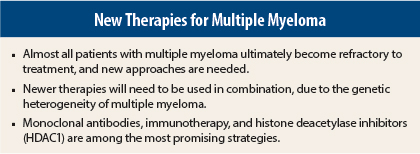New therapies for multiple myeloma have dramatically improved life expectancy, but despite these advances, 5-year overall survival still remains below 50%. Investigators are in hot pursuit of new therapies that will extend remissions and improve survival. Thus far, monoclonal antibodies, immunotherapy, histone deacetylase inhibitors, and the new proteasome inhibitor ixazomib show promise.
“There is still room for improvement. Multiple myeloma is treatable but not necessarily considered curable. Monoclonal antibodies are likely to play a key role in progress in treating the disease, and immunotherapy may be a key for refractory myeloma with high-risk genetics. There are a number of new targets and agents in the pipeline, and this is where personalized medicine may play a role,” said Sundar Jagannath, MD, Icahn School of Medicine at Mt. Sinai, New York. At the recent 2014 Chemotherapy Foundation Symposium, Dr. Jagannath updated listeners about promising new drugs for multiple myeloma.1
Ultimately, all patients become refractory to current treatments, he continued, attributing this mainly to the genetic complexity of the disease.
“At diagnosis, five different clones have been identified. With treatment, different clones emerge over time. There is selection of mutations, and this tells us that combination therapy is better than single-agent therapy,” Dr. Jagannath said.
“Right now in multiple myeloma, there is no molecularly targeted therapy. This is an area where progress has to be made,” he stated.
For a treatment to be considered an advance, it would have to boost complete and partial remission and achieve molecularly defined remission. Ideally, new agents should be well tolerated without causing cytopenias and demonstrate value across multiple lines of therapy.
“Multiple myeloma has many different treatment options and the path patients follow is different depending on response. A new therapy would need to show efficacy across different lines of therapy,” he told listeners.
About 15% to 29% of patients with multiple myeloma die within 3 years, even with novel agents. “For these high-risk groups, we want drugs that are genome neutral. This leads us to monoclonal antibodies,” he said.
Promising Approaches
Three monoclonal antibodies show promise in multiple myeloma: daratumumab, SAR650984, and an older drug called elotuzumab. All three drugs improve response rates as single agents in multiple myeloma and show encouraging activity when combined with standard drugs used in multiple myeloma, such as lenalidomide (Revlimid) and dexamethasone.
Based on the success of rituximab (Rituxan) in lymphoma and the fact that CD38 is highly expressed in multiple myeloma cells, developing an anti-CD38 monoclonal antibody is an active area of study in multiple myeloma. Daratumumab and SAR650984 are both anti-CD38 monoclonal antibodies in phase III testing, he continued.
Daratumumab as a single agent achieved excellent response rates in relapsed multiple myeloma.2 Responses were more robust when daratumumab is combined with lenalidomide/dexamethasone, Dr. Jagannath explained. In one phase II study, the combination of daratumumab plus lenalidomide/dexamethasone achieved responses in 15 of 20 patients.3
SAR650984 as a single agent achieved a 33% response rate in patients with relapsed/refractory multiple myeloma, similar to that seen with daratumumab. In a small study of 31 patients with relapsed/refractory multiple myeloma, overall benefit for the combination of SAR650984 plus lenalidomide/dexamethasone was 65%, overall response rate was 58%, very good partial response was 23%, and partial response was 35%.4
“Anti-CD38 monoclonal antibodies are very exciting. They currently have breakthrough designation from the U.S. Food and Drug Administration [FDA]. We hope to have these drugs available sooner rather than later,” Dr. Jagannath stated.
“Elotuzumab is another monoclonal antibody that has been around for a while, but the newer drugs stole its thunder,” he continued.
This drug targets SLAMF7, which is highly expressed in multiple myeloma cells and natural killer cells. This enables targeting multiple myeloma cells via natural killer cell–mediated mechanisms, Dr. Jagannath explained.
In phase II studies, elotuzumab did not have impressive single-agent activity, but dramatic responses were seen in the phase II ELOQUENT-2 trial, when elotuzumab was combined with lenalidomide/dexamethasone. The median duration of response was 11 to 15 months.5
“Immunotherapy is an area of intense interest in all of oncology, and this may be where future progress lies,” he continued. Checkpoint inhibitors, chimeric antigen receptor T cells, and approaches to stimulating innate immunity may hold promise in multiple myeloma.
Panobinostat, a pan histone deacetylase inhibitor, has showed promising results with a 4-month improvement in progression-free survival when combined with bortezomib (Velcade)/dexamethasone vs bortezomib/dexamethasone alone: median of 12 months progression-free survival vs 8.1 months, respectively.6 Subgroup analysis of progression-free survival revealed a strong benefit in poor-risk patients. [Editor’s note: During the 2014 Chemotherapy Foundation Symposium meeting, the FDA’s Oncology Drug Advisory Committee recommended against the approval of panobinostat based on results of the PANORAMA-1 trial. FDA is not obligated to follow the committee’s vote, but it generally does.]
The histone deacetylase inhibitor 6 inhibitor ACY-1215 showed encouraging activity alone and in combination with bortezomib in patients with relapsed/refractory multiple myeloa, he said. In these heavily pretreated patients, the response rate was 25%, and the clinical benefit rate was 60%. Responses were seen in bortezomib-refractory patients.7
Other Targets
Other targets in the pipeline include kinesin spindle protein inhibitors (ie, filanesib); AKT inhibitors (ie, afuresertib); CDK inhibitors (ie, dinaciclib); nuclear transport inhibitors; PI3K inhibitors; Bruton’s tyrosine kinase inhibitors; and BCL2 inhibitors.
“Dr. Jagannath has given us an excellent educational session about what to expect in the future for treatment of multiple myeloma,” said Kanti Rai, MD, session moderator. ■
Disclosure: Dr. Jagannath reported no potential conflicts of interest.
References
1. Jagannath S: New drugs in multiple myeloma. 2014 Chemotherapy Foundation Symposium. Presented November 5, 2014.
2. Lokhorst HM, Laubach J, Nahi H, et al: Dose-dependent efficacy of daratumumab as monotherapy in patients with relapsed or refractory multiple myeloma. 2014 ASCO Annual Meeting. Abstract 8513.
3. Plesner T, Arkenau H-T, Lokhorst HM, et al: Safety and efficacy of daratumumab with lenalidomide and dexamethasone in relapsed or relapsed, refractory multiple myeloma. 2014 ASCO Annual Meeting. Abstract 8533.
4. Martin TG, Hsu K, Charpentier E, et al: A phase 1b dose escalation trial of SAR650984 (Anti-CD38 mAb) in combination with lenalidomide and dexamethasone in relapsed/refractory multiple myeloma. 2014 ASCO Annual Meeting. Abstract 8512.
5. Richardson PG, Jagannath S, Moreau P, et al: A phase 2 study of elotuzumab in combination with lenalidomide and low-dose dexamethasone in patients with relapsed/refractory multiple myeloma: Updated results. 2012 ASH Annual Meeting. Abstract 202.
6. Richardson PG, Hungria VTM, Yoon S-S, et al: Panorama 1: A randomized, double-blind phase 3 study of panobinostat or placebo plus bortezomib and dexamethasone in relapsed or relapsed and refractory multiple myeloma. 2014 ASCO Annual Meeting. Abstract 8510.
7. Raje N, Vogl DT, Parameswaran NH, et al: ACY-1215, a selective histone deacetylase (HDAC) 6 inhibitor: Interim results of combination therapy with bortezomib in patients with multiple myeloma. 2013 ASH Annual Meeting. Abstract 759.



